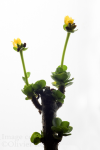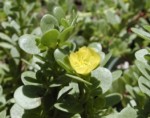Scientific Name: Portulaca lutea
Indigenous: Northwestern H.I., Oahu, Molokai, Maui, Lanai, and Hawaii
Description: Prostrate herbs with thick stems and tightly arranged, alternating leaves which are rounded and very succulent (very similar in apperance to the dwarf jade plant, only this plant is prostrate). On the top of the stems a small cup of leaves hold a cluster of yellow flowers each one about an inch and a half in diameter. This plant closely resembles and introduced Portulaca often referred to as pigweed, but that plant has very small yellow flowers about a quarter inch in diameter and often has softer stems that are red towards the base whereas the native one has a light tan, almost woody looking base.
Distribution: This type of ‘ihi (there are a few other native species found here) is an indigenous plant which naturally exists on coastal and strand habitats in medium such as lava, raised coral reef, sand and soil. It is found on the majority of the Northwestern Hawaiian Islands as well as O’ahu, Molokai, Maui, Lana’i and Hawai’i.
Landscape Use and Care: This species of ‘ihi, like most others prefer full sun with only the occasional watering. Daily watering is not recommended, rather soak the ground every 2-3 days to let the soil dry out. Sandy soil is also preferred for good drainage. When given daily watering, you will notice the plant “taking off”, becoming very large and healthy looking. Although, it looks nice then, the plant is actually becoming very “soft” and appetizing for pests. When in its natural state, few pests bother it, although mealy bugs are sometimes noticed at the leaf axis. These can be removed by hand or sprayed with pesticide. If the situation looks out of control, simply cut off the infected areas and allow the plant to grow back, keeping an eye on it to prevent future infestations. If you decide to add it to your yard, plant it as a bedding plant or at the base of larger landscape stones. They also look great in soil pockets between rock clusters. When in bloom, their yellow flowers really stand out against the darker rocks and if you’re lucky after they bloom they’ll drop their seeds creating a future stock of ‘ihi plants for your garden.
Ihi








